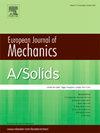Transient wave propagation in a 1-D gradient model with material nonlinearity
IF 4.4
2区 工程技术
Q1 MECHANICS
引用次数: 0
Abstract
A novel nonlinear 1-D gradient model has been previously proposed by the authors, combining (i) the higher-order gradient terms that capture the influence of material micro-structure and (ii) a nonlinear softening material behavior through the use of a hyperbolic constitutive model. While the previous study focused on the existence and properties of solitary-type waves, the current study focuses on the characteristics of the transient wave propagation in the proposed model. Findings show that as nonlinearity increases, the bulk of the wave slows down, and its shape becomes more distorted in comparison to the response of the linear system. The energy analysis reveals that, unlike the linear system, the nonlinear one continuously exchanges energy, in which the kinetic energy decreases over time while the potential one increases. Furthermore, the spectral (wavenumber) energy density of the nonlinear-elastic system presents peaks at large wavenumbers. However, these are eliminated when a small amount of linear viscous damping is added indicating that they are not physically relevant. A notable feature that persists despite the presence of damping is the formation of small-amplitude waves traveling in the opposite direction to the main wave. Generalized continua, like gradient elasticity models, miss the small energy scatter by the micro-structure. This study shows that adding material nonlinearity to a homogeneous generalized continuum can capture reverse energy propagation, though at much smaller magnitudes than the main wave. These findings shed light on the characteristics of the transient wave propagation predicted by the proposed nonlinear 1-D gradient model and its applicability in, for example, predicting the seismic site response.
求助全文
约1分钟内获得全文
求助全文
来源期刊
CiteScore
7.00
自引率
7.30%
发文量
275
审稿时长
48 days
期刊介绍:
The European Journal of Mechanics endash; A/Solids continues to publish articles in English in all areas of Solid Mechanics from the physical and mathematical basis to materials engineering, technological applications and methods of modern computational mechanics, both pure and applied research.

 求助内容:
求助内容: 应助结果提醒方式:
应助结果提醒方式:


